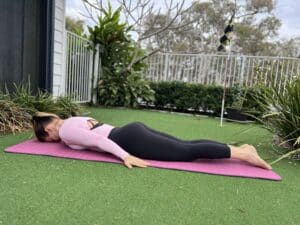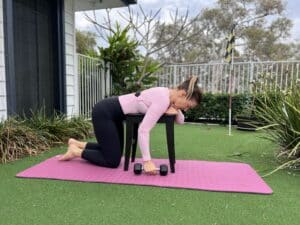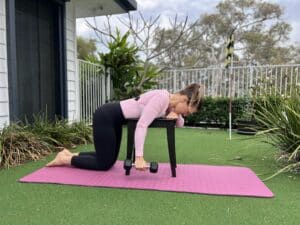Time to live pain free!
Welcome to the
AFGC Shoulder Conditioning
Program
Below, you will find effective and safe at-home workouts that can help you:
- Increase physical activity.
- Develop weaker or injured body parts.
- Decrease pain.
Our programs are designed to bring you pain relief for life.
Exercises and stretching techniques may bring you relief now, but to train your body, to live pain free for a long time, takes more than just a few sessions.
Just a few minutes per day can be crucial for your overall progress. By performing these quick, effective, and safe exercises at home, you will continue to gain added strength and flexibility. Our exercise conditioning program aims to assist you in returning to daily activities and enjoying a more active, healthy lifestyle.
Please do not ignore any pain. You should not experience pain during exercise. If you encounter any discomfort while exercising, consult your doctor or physical therapist.
STRENGTH
Strength training may enhance your quality of life and improve your ability to do everyday activities. Strength training can also protect your joints from injury. Building muscle also can contribute to better balance and may reduce your risk of falls. Strengthening the muscles that support your shoulder will reduce stress on your joint.
FLEXIBILITY
Stretching keeps the muscles flexible, strong, and healthy, and we need that flexibility to maintain a range of motion in the joints. Without it, the muscles shorten and become tight. Then, when you call on the muscles for activity, they are weak and unable to extend all the way. That puts you at risk for joint pain, strains, and muscle damage.
MOBILITY
Mobility is the overall range of motion a person has within their body, most notably within the joints. Mobility is incredibly important to one's health and daily functioning. Increased mobility prevents you from getting injuries. It allows you to move freely, lift your arms without pain, reach overhead easily, and perform everyday tasks with confidence and strength.
Your program
Here are the top 4 exercises that can help alleviate shoulder pain. These exercises should be done every day for 10 days. It will only take 5-10 minutes of your time. This is my recommended regimen, and you can easily incorporate it into your daily routine, either in the morning or evening.
1. Pendulum
- Main muscles worked: Deltoids, supraspinatus, infraspinatus, subscapularis
- Equipment needed: None
- Repetitions: 2 sets of 10
Step-by-step directions:
- Lean forward and place one hand on a counter or table for support. Let your other arm hang freely at your side.
- Gently swing your arm forward and back. Repeat the exercise by moving your arm side-to-side, and again in a circular motion.
- Repeat the entire sequence with the other arm.
Tip: Ensure your back remains straight and avoid locking your knees.
2. Sleeper Stretch
- Main muscles worked: Infraspinatus, teres minor
- Sensation: You should feel this stretch in your outer upper back, behind your shoulder
- Equipment needed: None
- Repetitions: 4 reps each side
Step-by-step directions:
- Lie on your side on a firm, flat surface with the affected shoulder under you and your arm bent, as shown. You can place your head on a pillow for comfort, if needed.
- Use your unaffected arm to gently push your other arm down. Stop pressing down when you feel a stretch in the back of your affected shoulder.
- Hold this position for 30 seconds, then relax your arm for 10 seconds.
Tip: Avoid bending your wrist or pressing down on your wrist.
3. Scapula Setting
- Main muscles worked: Middle trapezius, serratus
- Sensation: You should feel this exercise in your upper back, at your shoulder blade
- Equipment needed: None
- Repetitions: 10
Step-by-step directions:
- Lie on your stomach with your arms by your sides.
- Place a pillow under your forehead for comfort, if required.
- Gently draw your shoulder blades together and down your back as far as possible.
- Ease about halfway off from this position and hold for 5-6 seconds.
- Relax and repeat 10 times.
Tip: Avoid tensing up your neck.
4. Scapular Retraction/Protraction
- Main muscles worked: Middle trapezius, serratus
- Sensation: You should feel this exercise in your upper back at your shoulder blade
- Equipment needed: Begin with a weight that allows 2 sets of 8 to 10 repetitions and progress to 3 sets of 15 repetitions. As the exercise becomes easier, add weight in 2kg increments to a maximum 3kg. Each time you increase the weight, start again at 2 sets of 8 to 10 repetitions.
- Repetitions: 2 sets of 10
Step-by-step directions:
- Lie on your stomach on a table or bed with your arm hanging over the side.
- Keep your elbow straight and lift the weight slowly by squeezing your shoulder blade toward the opposite side as far as possible.
- Return slowly to the starting position and repeat.
Tip: Avoid shrugging your shoulder toward your ear.
Bonus videos
BONUS 1:
Foam rolling your Middle of the back
Instructions:
Get set-up with your butt supported on the ground with a foam roller supporting your mid-back. Position the foam roller in the middle of your back, then gently shift your upper back over the foam roller while exhaling. Move the foam roller to various areas of your mid-back to mobilize multiple segments. You only need to spend 30 seconds.
BONUS 2:
Foam rolling your Upper arm
Instructions:
Follow along with the video to learn how to roll out your upper arm! You only need to spend 30 seconds on each side.
BONUS 3:
Foam rolling your Back of your shoulder
Instructions:
In a side-lying position, position a foam roller just underneath your shoulder, targeting the large muscle located underneath the side of your shoulder. Roll from side to side, exploring this area to find what feels comfortable for you. Pay attention to your breathing as you perform this mobilisation. Make sure to use a softer foam roller. You only need to spend 30 seconds on each side.
We hope you find these exercises enjoyable and beneficial. If you have any questions about these exercises, or you need a foam roller, you can order one here: andifitnessgoldcoast@gmail.com.







